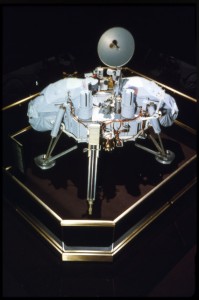Remember the Face on Mars?
/https://tf-cmsv2-smithsonianmag-media.s3.amazonaws.com/filer/faceonmars.jpg)
Thirty-three years ago this week, in one of the first images sent back from Mars, people thought they detected the likeness of a human face rising from the dust of the red planet. The photo was captured by Viking 1, the first spacecraft to successfully travel to and land on Mars.
The image inspired tabloid headlines like "Monkey Face on Mars" and books like Richard Hoagland's The Monuments of Mars, in which Hoagland claimed, based on the photos, to have seen "an entire city laid out — on Mars! — with the precision of a Master Architect. I had indeed discovered some kind of artificially constructed Martian 'complex.'"
Once the public saw the "Face on Mars," as it came to be called, people became interested in the neighboring planet and possible life there. The trouble, says Smithsonian geologist John Grant of the Center for Earth and Planetary Studies, is that people assumed it was a sign of advanced alien life.
"In fact, there was a little bit of a misconception about what kind of life scientists were trying to discover on Mars, which was relatively simple life versus complicated life forms that were carving big faces in rocks," Grant explains.
When scientists first viewed the image, they were confident it was an eroded rock formation, probably a mesa. High resolution photos taken in 1998 and 2001 have confirmed that the "Face on Mars" is a trick of the eye, seen when light hits the mesa at a certain angle. Different parts of the planet's surface are more resistant to erosion than others and don’t erode as quickly, leaving some areas higher and others lower. This process forms a relief that then creates the shadow, making it look like a face at certain times.
Grant likes to compare it to the Old Man in the Mountain in New Hampshire (which fell down in 2003). "No one ever thought that the Old Man in the Mountain was something carved by people or aliens or anything else. Yet they could look at it and say: 'Oh yeah, I see how the sun is shining on that and shadows are cast and it looks like a man’s head,'" he says.
"The same thing can happen on Mars and produce something that, just by sheer coincidence and the way erosion has occurred, creates something that looks like a face," Grant adds.
The spacecraft Viking 1, that captured the iconic image, was launched on Aug. 20, 1975, followed one month later by Viking 2. While orbiting Mars, a camera onboard Viking I began scanning potential landing sights, beaming the images back to Earth. In the early morning of July 20, 1976, the Viking 1 lander separated from the orbiter and successfully descended to the surface at about 10,000 miles per hour. Viking 2 followed on Sept. 3, 1976.
The two Viking spacecraft collected information about Martian atmosphere, meteorology and soil composition, and captured more than 50,000 images during their time in orbit and on the surface.
A test version of the Viking Lander now resides in the Milestones of Flight Gallery at the National Air and Space Museum.
